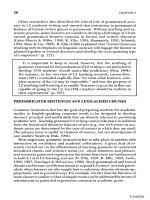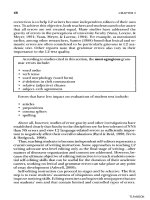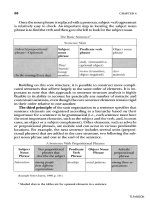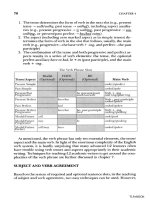ESL library discussion starters bad habits
Bạn đang xem bản rút gọn của tài liệu. Xem và tải ngay bản đầy đủ của tài liệu tại đây (336.22 KB, 0 trang )
Bad Habits
Discussion Starters
Brainstorm ☀
Work together as a class. How many examples of bad habits can you think of?
Pre-Reading Warm Up Questions ☀
1. What is the difference between conscious and subconscious?
2. How can you break a bad habit?
3. Have you ever quit anything “cold turkey”?
Pre-Reading Vocabulary Task ☀
Match the words on the left with the meanings on the right.
1. twirl
2. subconscious
3. fatigue
4. conscious
5. admit
6. once and for all
7. follow through
8. quit cold turkey
9. setbacks
10. inevitable
11. log
12. kick a habit
a) fully aware; on purpose
b) to stop (a habit) instantly and never do it
again
c) to break a subconscious pattern
d) to keep track in a chart
e) tiredness
f) to make something go around and around
g) finally, without any chance of changing your mind
h) events or situations that prevent or delay your goal
i) automatic; not based on thinking
j) will happen no matter what
k) to stick to your plan
l) to tell the truth
Bad Habits
How can we break them?
Do you bite your nails or twirl your hair? Maybe you eat too quickly or check your email ten times an
hour. Most of us have one bad habit or another. Habits are subconscious. This means we perform them
automatically without thinking. Stress, boredom, and fatigue can cause our habits to worsen.
Experts say it takes three months to form a habit. How long does it take to break a habit? Unlike biting
your nails, breaking this habit requires conscious effort. The first thing to do is to admit what your habit is.
Next, decide once and for all that you are ready to break it. Come up with a plan and follow through. You
don’t have to quit cold turkey. Accept that there will be setbacks; they are inevitable. Don’t beat yourself up
when you have a setback. Think of the well known saying: “If at first you don’t succeed, try, try again.”
Do you get any enjoyment out of your habit? It is a good idea to name the reasons why your habit is “bad”.
Does it embarrass you or others? Does it cost a lot of money? Tell other people your plan to break this habit.
Log your progress and your setbacks. When you kick your habit, congratulate yourself! Now you have the
tools to break the next one.
Copyright 2011. This eBook is produced and distributed by Red River Press Inc. All rights reserved. The contents within this e-book/document may only be
photocopied by members of ESL-Library.com in accordance with membership terms and conditions. Contact for complete details.
Bad Habits
Discussion Starters
Punctuation Tip: Semicolon
Use a semicolon to separate two complete thoughts that are short and related. Do not
use a comma. → ;
“Accept that there will be setbacks; they are inevitable.”
Comprehension Questions
✍
According to the reading are the following statements True or False? If the statement is
false, correct the information.
1. Checking email many times an hour is an example of a bad habit.
2. Extreme tiredness can cause a person to perform a bad habit.
3. The best way to quit a bad habit is cold turkey.
4. It usually takes three months to break a bad habit.
5. People who are trying to break a bad habit should keep their plan to themselves.
Vocabulary Review ✍
Spot the Error
Circle the vocabulary error in the sentences below. Rewrite the sentence properly.
1. I am fatigue when I get home from school.
2. It took me two years to quit smoking. I can’t believe you quit cold chicken!
3. I decided to quit biting my nails once and for many.
4. Inevitable you will have setbacks. You can’t avoid them.
5. I will to log how many times I bite my nails each day.
Speaking and Listening Practice
Class Panel
Observe at least three members of your class as they debate this statement. The panel should sit together at the front of
the class.:
“ Swearing is a bad habit that young people must quit before entering the workforce. ”
What was the strongest argument?
Which point did the speakers disagree on?
What points did the panel leave out?
Do you agree or disagree with the speakers’ points?
Group or Pair Discussion or Individual Writing Prompt ✍
1. Is it easier to make or break a bad habit?
2. What is the most common bad habit and why?
3. Can you grow out of a bad habit subconsciously?
4. What’s the difference between a bad habit and an addiction?
Copyright 2011. This eBook is produced and distributed by Red River Press Inc. All rights reserved. The contents within this e-book/document may only be
photocopied by members of ESL-Library.com in accordance with membership terms and conditions. Contact for complete details.
Bad Habits
Discussion Starters
ANSWER KEY and Notes
Pre-reading Vocabulary Task
1. f
2. i
3. e
4. a
5. l
6. g
7. k
8. b
9. h.
10. j
11. d
12. c
Comprehension Questions
1. True
2. True
3. False. The best way to quit a bad habit is to follow through with your plan but admit that there will be setbacks.
4. False. It usually takes three months to form a bad habit.
5. False. People who are trying to break a bad habit should tell others their plan to break the habit.
Vocabulary Review
Spot the error
1. I am fatigued when I get home from school.
2. It took me two years to quit smoking. I can’t believe you quit cold turkey!
3. I decided to quit biting my nails once and for all.
4. It is inevitable that you will have setbacks. You can’t avoid them. / Inevitably you will have setbacks.
5. I will log how many times I bite my nails each day.
Class Panel Notes
Choose about 3 students to discuss the statement. If they all agree, have one student debate from the other side
of the argument. If you have extra time, have students take turns being on the panel. Change the topic if you
want. You can use the Discussion Topics from this lesson for Class Panel topics.
Copyright 2011. This eBook is produced and distributed by Red River Press Inc. All rights reserved. The contents within this e-book/document may only be
photocopied by members of ESL-Library.com in accordance with membership terms and conditions. Contact for complete details.


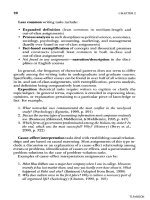
![Brook-Hart - Business Benchmark Advanced - Student''''s Book [ESL English] (Cambridge, 2007)(AnswerKey)](https://media.store123doc.com/images/document/13/to/zu/medium_92z3Htlnzt.jpg)
